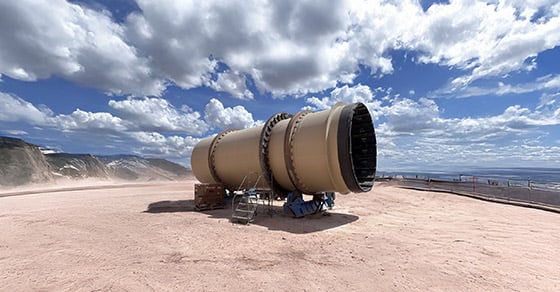In heap leaching operations, the selection of agglomerators plays a pivotal role in determining the efficiency and profitability of the process. While opting for low-cost agglomeration drums may seem a cost-effective decision initially, it’s essential to consider the long-term implications on operational performance and maintenance costs.
The Growing Heap Leaching Market and the Increasing Use of Agglomeration
The heap leaching market has seen significant growth in recent years, driven by the demand for more efficient and cost-effective methods of extracting valuable metals from lower-grade ores.
As high-grade ore deposits become scarcer, mining operations are increasingly turning to lower-grade ores, making heap leaching an essential method in the industry. This trend is expected to continue as global demand for minerals like gold, copper, and critical metals rises.
Agglomeration is widely incorporated into the heap leaching process flow to improve the efficiency and effectiveness of the leaching process. By binding fine particles together to form larger, more uniform pellets, the ore pile exhibits better permeability, allowing leach solutions to flow more effectively. This uniformity ensures that the leachate contacts the material more consistently, maximizing recovery rates and minimizing waste.
The use of agglomeration brings several advantages to heap leaching, including:
- Reduced Clogging and Fines Migration: By binding fine particles together, agglomeration prevents fines from clogging flow channels within the heap, which can lead to inefficient leaching and loss of valuable material.1
- Improved Metal Recovery: Agglomeration enhances the contact between the leachate and the ore, which leads to higher recovery rates of valuable metals.2
- Increased Heap Permeability: Agglomerated ore allows leachate to percolate more easily, improving the overall efficiency of the heap leaching process.
- Shorter Leach Times: The improved structure and more porous nature of an agglomerated heap can lead to faster leach cycles.2
- A More Stable Heap: Agglomeration can create a heap with improved structural stability, allowing material to be heaped higher, and ultimately resulting in increased production.2
As the heap leaching market continues to grow, and mining operations increasingly focus on lower-grade ores, the demand for efficient agglomeration technologies will continue to rise. This makes the selection of the right agglomeration drum—one that is durable, efficient, and cost-effective—crucial for ensuring long-term operational success.
The Risks of Low-Cost Agglomerators
The exact risks associated with selecting a low-cost solution are hard to predict, but often lead to reduced durability and increased maintenance.
Low-cost drums utilize inferior materials and lighter-gauge metals, leading to faster wear and tear. This results in more frequent maintenance and downtime, escalating operational costs over time. It can also lead to a shorter service life and early equipment failure.
Advantages of Investing in High-Quality Agglomeration Drums
By contrast, an agglomeration drum fit for duty typically lends:
- Enhanced Durability and Reliability: High-quality drums are constructed with superior materials, ensuring longer service life and reduced maintenance needs, thereby lowering total cost of ownership.
- Improved Agglomeration Efficiency: Well-designed and fabricated drums provide consistent and effective mixing, leading to uniform pellet formation for optimal heap permeability.
- Energy Efficiency: Well-designed, high-quality drums often operate more efficiently, which can lead to reduced energy consumption and associated costs, while maintaining or increasing throughput.
- Better Environmental Compliance: Efficient agglomeration minimizes fines migration and ensures stable heap structures, aiding in compliance with environmental regulations and reducing potential liabilities.
Strategic Considerations for Procurement
When procuring agglomeration drums, it’s crucial to evaluate the total cost of ownership rather than focusing solely on initial capital expense. Factors such as durability, maintenance requirements, energy consumption, and environmental impact should be considered to make an informed decision that aligns with long-term operational goals.
Implications of U.S. Policies on Domestic Mineral Production
The U.S. government’s recent initiatives to bolster domestic production of critical minerals have significant implications for mining operations. President Trump’s executive orders aim to expedite permitting processes for mining projects and reduce reliance on foreign suppliers. These policies are expected to increase demand for mining equipment, including agglomeration drums, as operations expand and new projects commence.
Conclusion
Investing in high-quality agglomerators is a strategic decision that can lead to enhanced operational efficiency. As the demand for domestic mineral production grows, ensuring that heap leaching operations are equipped with reliable and efficient equipment positions mining companies for long-term success in a competitive market.
FEECO is the leading provider of high-quality agglomerators, with installations all over the world. Extremely robust, and with extensive parts and service support, FEECO agglomeration drums are the industry’s preferred equipment for heap leaching operations. For more information on our agglomerators, contact us today!
SOURCES:
1. Bouffard, Sylvie C. “Review of agglomeration practice and fundamentals in heap leaching.” Mineral Processing and Extractive Metallurgy Review, vol. 26, no. 3-4, July 2005, pp. 233–294. https://doi.org/10.1080/08827500590944009.
2. “Novel Binders and Methods for Agglomeration of Ore.” U.S. Department of Energy, Office of Scientific and Technical Information, 2005. https://www.osti.gov/servlets/purl/840351.

